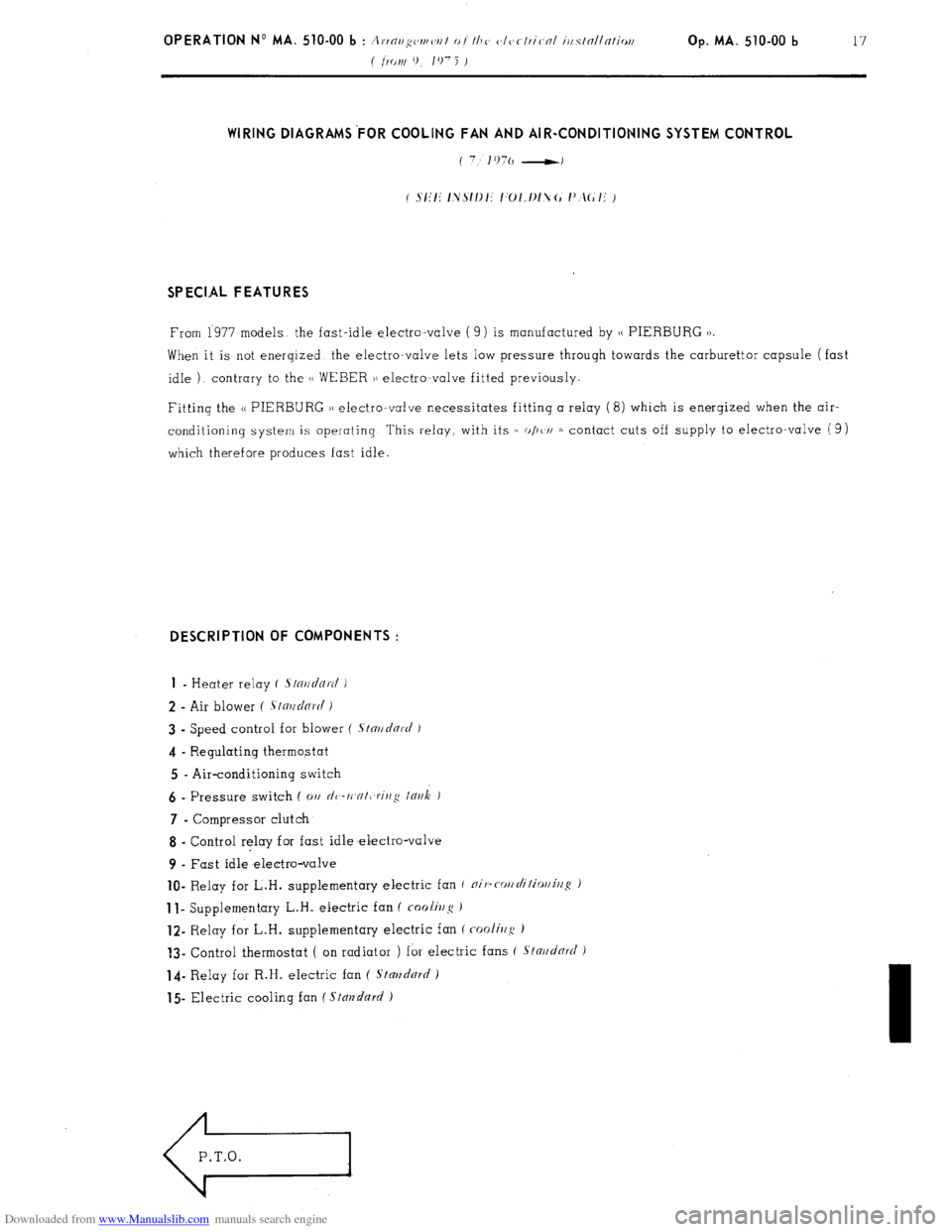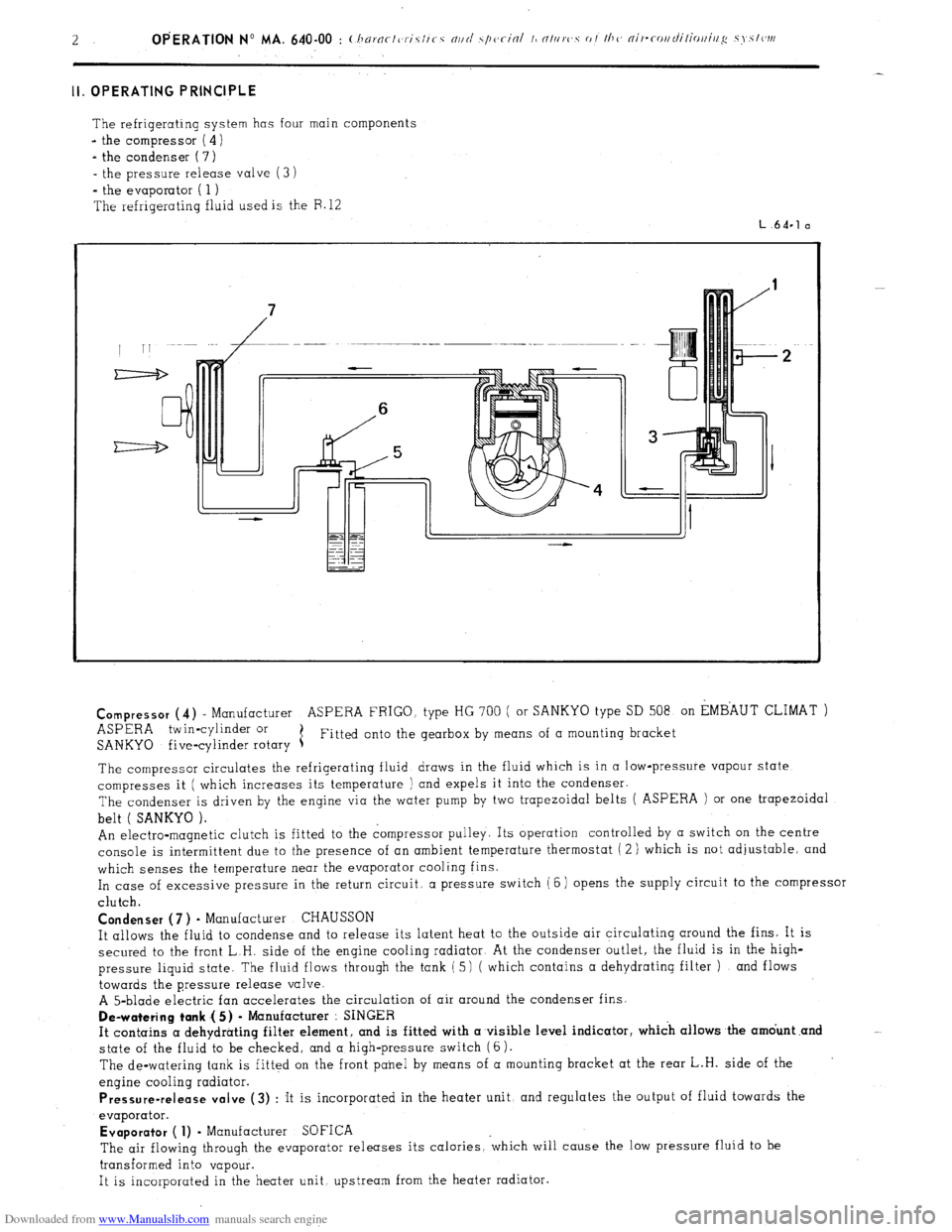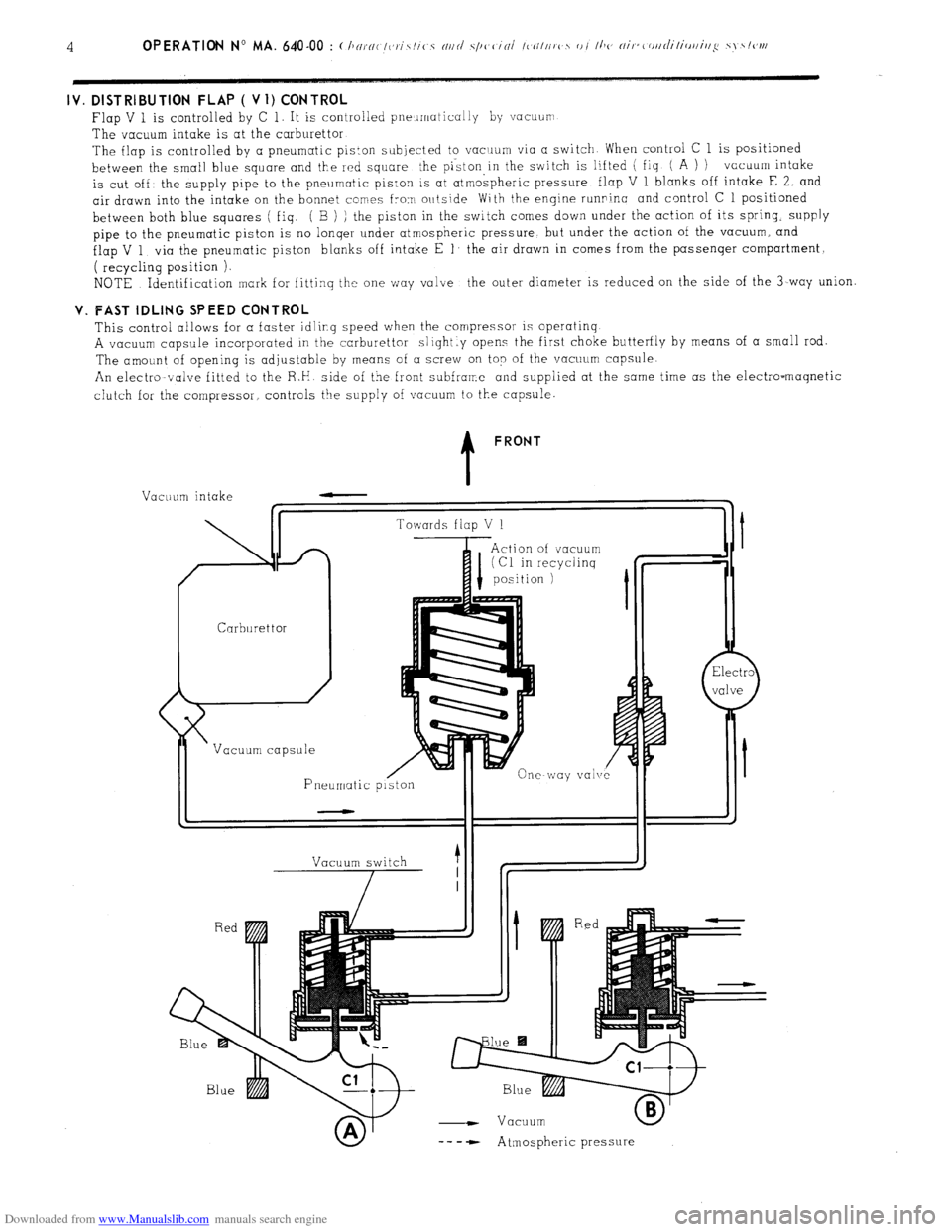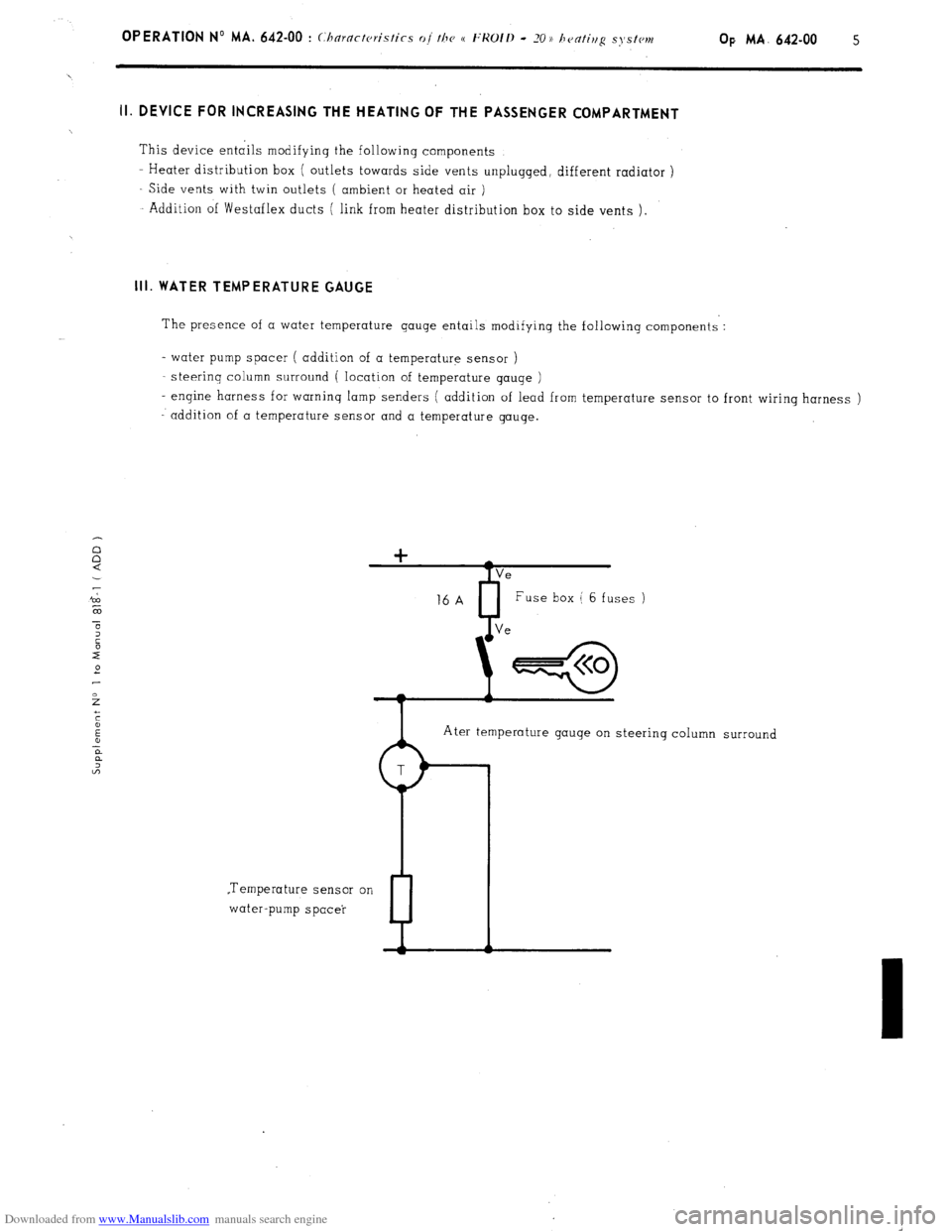tow Citroen CX 1984 1.G Owner's Manual
[x] Cancel search | Manufacturer: CITROEN, Model Year: 1984, Model line: CX, Model: Citroen CX 1984 1.GPages: 394
Page 334 of 394

Downloaded from www.Manualslib.com manuals search engine Op. MA. 510-00 b 17 WIRING DIAGRAMS’FOR COOLING FAN AND AIR-CONDITIONING SYSTEM CONTROL
SPECIAL FEATURES
From 1977 models the fast-idle electro-valve ( 9) is manufactured by 1, PIERBURG 1).
When it is not enerqized the electro-valve lets low pressure through towards the carburettor capsule (fast
idle ) contrary to the (1 WEBER )) electromvalve fitted previously.
Fitting the N PIERBURG )) electro-valve necessitates fitting a relay (8) which is enerqized when the air-
conditioning system is operating This relay, with its c( o/)t/i 1) contact cuts off supply to electro-valve (9)
which therefore produces fast idle. DESCRIPTION OF COMPONENTS :
1
- Heater relay ( .s/o~/~/Q~c/ )
2 - Air blower ( .S~n~~dnr(i i
3 - Speed control for blower ( S/nr/clnrt/ J
4 - Regulating thermostat
5 - Air-conditioning switch 6
- Pressure switch ( 01, dc,-rt,cr/t,rit,,q lnr~k ) 7
- Compressor clutch
8 - Control relay for fast idle melectro-valve
9 - Fast idle electro-valve lo-
Relay for L.H. supplementary electric fan f nip-cor/rli/ior/illS ) 1
I- Supplementary L.H. electric fan ( foolir2~~ ) 12-
Relay for L.H. supplementary electric fan ( cooli~/g ) ?3-
Control thermostat ( on radiator ) for electric fans ( Stnr~d& )
14- Relay for R.H. electric fan ( Stmzdnrrl )
15 Electric cooling fan ( Stal?dn~/ )
Page 362 of 394

Downloaded from www.Manualslib.com manuals search engine II. OPERATING PRINCIPLE
The refrigerating system has four main components
- the compressor ( 4)
- the condenser ( 7)
- the pressure release valve (3 i
*
the evaporator ( 1 )
The refrigerating fluid used is the F. 12
L.64.1 a
Compressor
(4) - Manufacturer ASPERA FRIGO. type HG 700 ( or SANKYO type SD 508 on EMBAUT CLIMAT )
ASPERA twin-cylinder or
SANKYO five-cylinder rotary 1 Fitted onto the gearbox by means of a mounting bracket
The compressor circulates the refrigerating fluid draws in the fluid which is in a low-pressure vapour state
compresses it ( which increases its temperature ) and expels it into the condenser.
The condenser is driven by the engine via the water pump by two trapezoidal belts ( ASPERA ) or one trapezoidal
belt ( SANKYO ).
An electro-magnetic clutch is fitted to the compressor pulley. Its operation controlled by a switch on the centre
console is intermittent due to the presence of an ambient temperature thermostat ( 2 ) which is not adjustable, and
which senses the temperature near the evaporator cooling fins.
In case of excessive pressure in the return circuit, a pressure switch (6) opens the supply circuit to the compressor
clutch.
Condenser (7 ) - Manufacturer CHAUSSON
It allows the fluid to condense and to release its latent heat to the outside air circulating around the fins. It is
secured to the front L.H. side of the engine cooling radiator At the condenser outlet, the fluid is in the high-
pressure liquid state. The fluid flows through the tank ( 5) ( which contains a dehydrating filter ) and flows
towards the pressure release valve.
A 5-blade electric fan accelerates the circulation of air around the condenser fins.
De-watering tank .( 5) - Manufacturer : SINGER
It contains a dehydrating filter element, and is fitted with a visible level indicator, which allows the amdunt .and
state of the fluid to be checked, and a high-pressure switch (6).
The de-watering tank is fitted on the front panel by means of a mounting bracket at the rear L.H. side of the
engine cooling radiator.
Pressure-release valve (3) : It is incorporated in the heater unit, and regulates the output of fluid towards the
evaporator.
Evaporator ( 1) - Manufacturer SOFICA
The air flowing through the evaporator releases its calories, ‘which will cause the low pressure fluid to be
transformed into vapour.
It is incorporated in the heater unit upstream from the heater radiator.
Page 364 of 394

Downloaded from www.Manualslib.com manuals search engine IV. DISTRIBUTION FLAP ( Vl) CONTROL
Flap V 1 is controlled by C 1. It is controlled pneumatically by vacuurr
The vacuum intake is at the carburettor
The flap is controlled by a pneumatic piston subjected to vacrrum via a switch When control C 1 is positioned
between the small blue square and the red square the piston,in the switch is lifted ( fiq ( A ) ) vacuum intake
is cut off’ the supply pipe to the pneumatic piston is at atmospheric pressure flap V 1 blanks off intake E 2, and
air drawn into the intake on the bonnet comes from outside With the engine runninc and control C 1 positioned
between both blue squares ( fiq. ( B ) ) the piston in the switch comes down under the action of its spring.
supply
pipe to the pneumatic piston is no lonqer under atmospheric pressure but under the action of the vacuum, and
flap V 1 via the pneumatic piston blanks off intake E 1’ the air drawn in comes from the passenqer compartment,
( recycling position ).
NOTE Identification mark for fittinq the one way valve the outer diameter is reduced on the side of the 3-way union V. FAST IDLING SPEED CONTROL
This control allows for a faster idling speed when the compressor is operatinq
A vacuum capsule incorporated in the carburettor slightly opens the first choke butterfly by means of a small rod.
The amount of opening is adjustable by means of a screw on top of the vacuum capsule.
An electromvalve fitted to the R.H side of the front subframe and supplied at the same time as the electro-maqnetic
clutch for the compressor controls the supply of vacuum to the capsule. t FRONT
Vacuum intake
Carburettor /
Vacuum capsule
Pneumatic p Towards flap V 1
Action of vacuum
I (Cl in recyclinq
position 1
vale
Vacuum switch
7 1
- Vacuum
-- - - Atmospheric pressure
Page 380 of 394

Downloaded from www.Manualslib.com manuals search engine Op MA. 642-00 5 II. DEVICE FOR INCREASING THE HEATING OF THE PASSENGER COMPARTMENT
This device entails modifying the following components
- Heater distribution box ( outlets towards side vents unplugged, different radiator )
Side vents with twin outlets ( ambient or heated air )
Addition of Westaflex ducts ( link from heater distribution box to side vents ). III. WATER TEMPERATURE GAUGE
The presence of a water temperature gauge entails modifying the following components :
- water pump spacer ( addition of a temperature sensor )
steerinq column surround ( location of temperature gauqe )
- engine harness for warning lamp senders ( addition of lead from temperature sensor to front wiring harness )
addition of a temperature sensor and a temperature gauge.
Ater temperature gauge on steering column surround
.Temperature sensor on
water-pump spacer
P